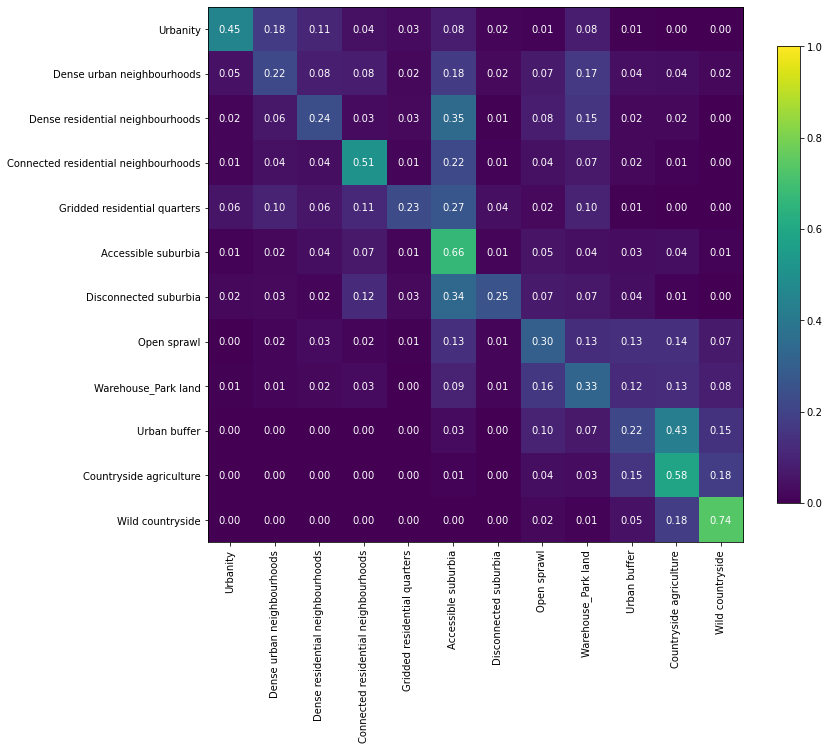Evaluation of the effect of chip size and origin¶
Compare performance of various models in relation to a chip size and origin (mosaic vs temporal)
import json
import glob
from itertools import product
import numpy
import pandas as pd
import matplotlib.pyplot as plt
import seaborn
import urbangrammar_graphics as ugg
path = "../../urbangrammar_samba/spatial_signatures/ai/gb_*_shuffled/json/"
results = glob.glob(path + "*")
names = [i[64:-5] + "_" + i[47:49] for i in results]
with open(results[0], "r") as f:
result = json.load(f)
accuracy = pd.DataFrame(columns=["global"] + result["meta_class_names"], index=pd.MultiIndex.from_product([names, ["train", "val", "secret"]]))
for r in results[:-1]:
with open(r, "r") as f:
result = json.load(f)
accuracy.loc[(result["model_name"]+ "_" + r[47:49], "train")] = [result["perf_model_accuracy_train"]] + result["perf_within_class_accuracy_train"]
accuracy.loc[(result["model_name"]+ "_" + r[47:49], "val")] = [result["perf_model_accuracy_val"]] + result["perf_within_class_accuracy_val"]
accuracy.loc[(result["model_name"]+ "_" + r[47:49], "secret")] = [result["perf_model_accuracy_secret"]] + result["perf_within_class_accuracy_secret"]
accuracy
| global | centres | periphery | Countryside agriculture | Wild countryside | Urban buffer | ||
|---|---|---|---|---|---|---|---|
| efficientnet_pooling_256_5_16 | train | 0.540909 | 0.716571 | 0.469743 | 0.500086 | 0.732914 | 0.285229 |
| val | 0.532293 | 0.7104 | 0.4596 | 0.490533 | 0.728267 | 0.272667 | |
| secret | 0.537547 | 0.733733 | 0.453333 | 0.4912 | 0.730533 | 0.278933 | |
| efficientnet_pooling_256_5_64 | train | 0.825237 | 0.999681 | 0.978119 | 0.608968 | 0.857752 | 0.681666 |
| val | 0.599028 | 0.876449 | 0.346168 | 0.480374 | 0.777009 | 0.51514 | |
| secret | 0.537702 | 0.698892 | 0.311963 | 0.46972 | 0.779252 | 0.511028 | |
| efficientnet_pooling_256_5_32 | train | 0.631566 | 0.912743 | 0.5622 | 0.5084 | 0.826914 | 0.347571 |
| val | 0.561333 | 0.754533 | 0.4884 | 0.469467 | 0.796667 | 0.2976 | |
| secret | 0.561562 | 0.747511 | 0.494267 | 0.474133 | 0.800533 | 0.312933 |
accuracy.xs('val', level=1).sort_index().plot.bar(figsize=(22, 10), title="validation")
<AxesSubplot:title={'center':'validation'}>
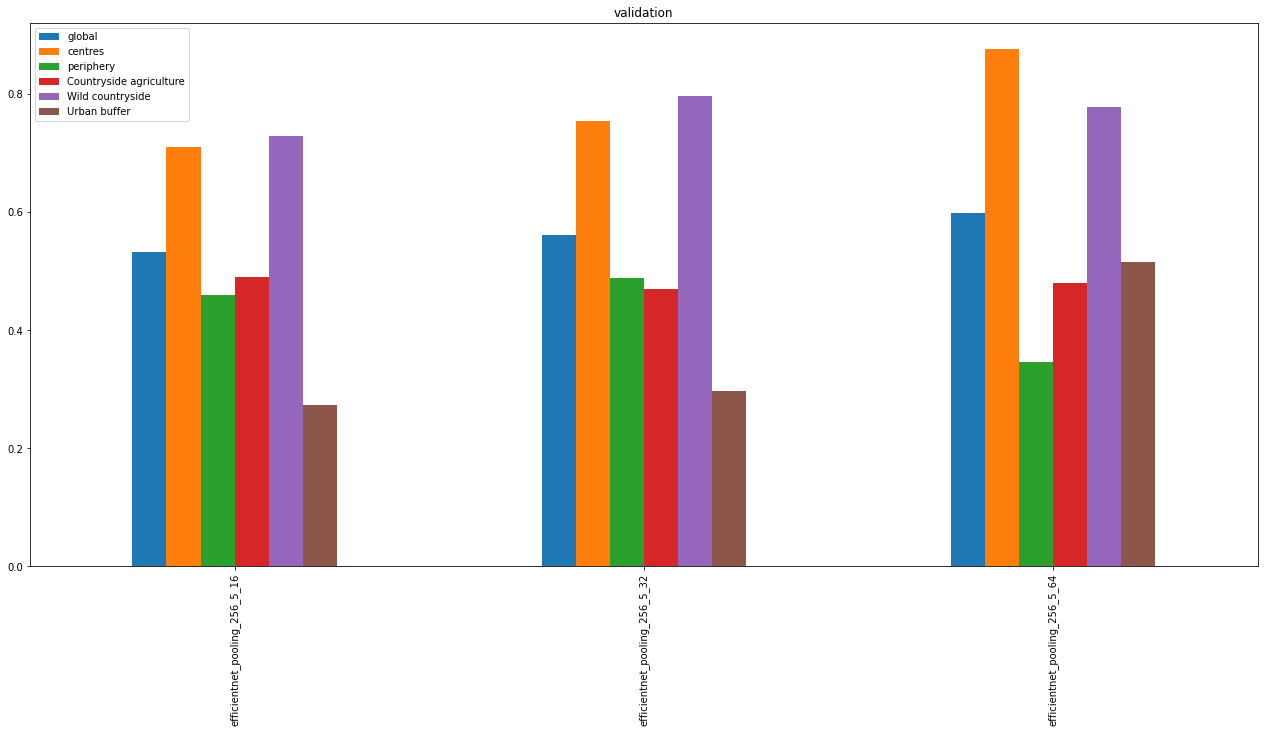
Notes:
overall accuracy is unimpressive
in princple, larger chips have a better performance but there’s a big but - if you don’t do massive aggregation, you don’t have enough data for urban signature types
we’re not horrible in predicting centres and wild countryside
urban buffer is a challenging class due to the amout of greenery
periphery and countryside are somewhere in between
we’re good in predicting urban vs non-urban (two blocks on the confusion matrices)
we’re not putting urban buffer to countryside classes (conceptually) but the neural net is (empirically)
32 is empircally a better way of approximating signatures than 64 - when there is a space to fit 64x64 chip, it usually covers some adjacent green space because other signature types are too small to fit enough chips
this could be mitigating by preferring chips with the larger number of intersections with underlying ET cells
count the number of intersections, sort and get N chips with the largest number. That way you limit the number of chips from large ET cells covering greenery.
ordered confusion matrix has a pattern similar to co-occurency matrix of singature types (empirical paper)
To-do:
prediction on 12 classes (combine only urbanity) and analyse the confusion matrix to know which to combine
we can try two parallel models, one with a single chip and another one with 3x3 chips around (or a few sampled) and merge before the end with a Dense to combine them [spatial lag]
Next steps:
prediction on 12 classes using 32x32 chips
deirive aggregation
pipeline for John’s data to get way more chips
replicate 32x32 training with the new chips
both 12 classes and aggregation
consider elimination of chips from large green ET cells (see note 8)
consider parallel model
Timeline:
Revisions by end of Feb
Empirical paper submitted by end of Apr
AI experiments by end of Apr
AI paper submitted by end of June
fig, axs = plt.subplots(1, 3, figsize=(18, 6))
for i, r in enumerate(sorted(results)):
with open(r, "r") as f:
result = json.load(f)
a = numpy.array(result['perf_confusion_val'])
a = a / a.sum(axis=1)[:, numpy.newaxis]
a = pd.DataFrame(a).iloc[[0,1,2,4,3],[0,1,2,4,3]].values
im = axs[i].imshow(a, cmap="viridis", vmin=0, vmax=1)
for k, j in product(range(5), range(5)):
axs[i].text(j, k, "{:.2f}".format(a[k, j]),
ha="center", va="center", color="w")
axs[i].set_title(result['meta_chip_size'])
# add labels
fig.colorbar(im, ax=axs[:], shrink=.7)
<matplotlib.colorbar.Colorbar at 0x7f5042555a30>

fig, axs = plt.subplots(1, 3, figsize=(18, 6))
for i, r in enumerate(sorted(results)):
with open(r, "r") as f:
result = json.load(f)
a = numpy.array(result['perf_confusion_val'])
a = a / a.sum(axis=1)[:, numpy.newaxis]
im = axs[i].imshow(a, cmap="viridis", vmin=0, vmax=1)
for k, j in product(range(5), range(5)):
axs[i].text(j, k, "{:.2f}".format(a[k, j]),
ha="center", va="center", color="w")
axs[i].set_title(result['meta_chip_size'])
fig.colorbar(im, ax=axs[:], shrink=.7)
<matplotlib.colorbar.Colorbar at 0x7f2dd8fd27f0>

fig, axs = plt.subplots(1, 3, figsize=(18, 6))
for i, r in enumerate(sorted(results)):
with open(r, "r") as f:
result = json.load(f)
a = numpy.array(result['perf_confusion_train'])
a = a / a.sum(axis=1)[:, numpy.newaxis]
im = axs[i].imshow(a, cmap="viridis", vmin=0, vmax=1)
for k, j in product(range(5), range(5)):
axs[i].text(j, k, f"{a[k, j]:.2f}",
ha="center", va="center", color="w")
axs[i].set_title(result['meta_chip_size'])
fig.colorbar(im, ax=axs[:], shrink=.7)
<matplotlib.colorbar.Colorbar at 0x7f2dd8d67e50>

12 classes¶
results
['../../urbangrammar_samba/spatial_signatures/ai/gb_16_shuffled/json/efficientnet_pooling_256_5.json',
'../../urbangrammar_samba/spatial_signatures/ai/gb_32_shuffled/json/efficientnet_pooling_256_12.json',
'../../urbangrammar_samba/spatial_signatures/ai/gb_32_shuffled/json/efficientnet_pooling_256_5.json',
'../../urbangrammar_samba/spatial_signatures/ai/gb_64_shuffled/json/efficientnet_pooling_256_5.json']
with open(results[1], "r") as f:
result = json.load(f)
result["meta_class_names"] = [
"Urbanity",
"Dense residential neighbourhoods",
"Connected residential neighbourhoods",
"Dense urban neighbourhoods",
"Accessible suburbia",
"Open sprawl",
"Warehouse/Park land",
"Gridded residential quarters",
"Disconnected suburbia",
"Countryside agriculture",
"Wild countryside",
"Urban buffer"
]
accuracy = pd.DataFrame(columns=["global"] + result["meta_class_names"], index=pd.Index(["train", "val", "secret"]))
accuracy.loc["train"] = [result["perf_model_accuracy_train"]] + result["perf_within_class_accuracy_train"]
accuracy.loc["val"] = [result["perf_model_accuracy_val"]] + result["perf_within_class_accuracy_val"]
accuracy.loc["secret"] = [result["perf_model_accuracy_secret"]] + result["perf_within_class_accuracy_secret"]
accuracy
| global | Urbanity | Dense residential neighbourhoods | Connected residential neighbourhoods | Dense urban neighbourhoods | Accessible suburbia | Open sprawl | Warehouse/Park land | Gridded residential quarters | Disconnected suburbia | Countryside agriculture | Wild countryside | Urban buffer | |
|---|---|---|---|---|---|---|---|---|---|---|---|---|---|
| train | 0.62358 | 0.844 | 0.677061 | 0.7896 | 0.2669 | 0.731106 | 0.7369 | 0.6127 | 0.4265 | 0.4537 | 0.822284 | 0.729964 | 0.5854 |
| val | 0.420283 | 0.618 | 0.328 | 0.7345 | 0.174 | 0.428009 | 0.302 | 0.4855 | 0.2905 | 0.3175 | 0.40856 | 0.476336 | 0.498 |
| secret | 0.428244 | 0.553905 | 0.28684 | 0.753 | 0.1915 | 0.384058 | 0.339 | 0.5035 | 0.285 | 0.327 | 0.608543 | 0.294023 | 0.5175 |
accuracy.loc['val'].sort_values(ascending=False).plot.bar(figsize=(22, 10), title="validation")
<AxesSubplot:title={'center':'validation'}>
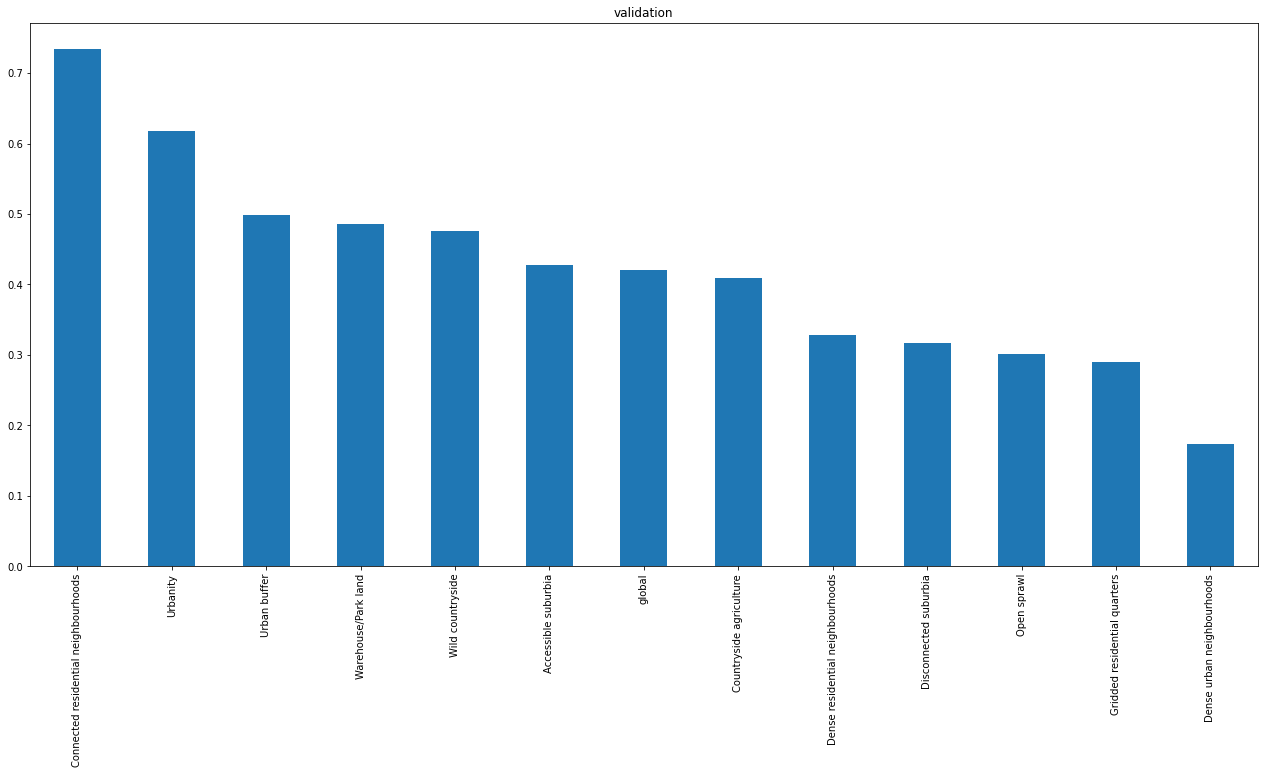
a = numpy.array(result['perf_confusion_val'])
a = a / a.sum(axis=1)[:, numpy.newaxis]
order = numpy.array([0, 3, 1, 2, 7, 4, 8, 5, 6, 11, 9, 10], dtype=int)
a = pd.DataFrame(a).iloc[order, order].values
fig, ax = plt.subplots(figsize=(12, 12))
im = plt.imshow(a, cmap="viridis", vmin=0, vmax=1)
for k, j in product(range(12), range(12)):
plt.text(j, k, "{:.2f}".format(a[k, j]),
ha="center", va="center", color="w")
fig.colorbar(im, ax=ax, shrink=.7)
plt.xticks(range(12),numpy.array(result["meta_class_names"])[order], rotation=90)
plt.yticks(range(12),numpy.array(result["meta_class_names"])[order])
([<matplotlib.axis.YTick at 0x7efc65b62610>,
<matplotlib.axis.YTick at 0x7efc65b7ce20>,
<matplotlib.axis.YTick at 0x7efc65b7c310>,
<matplotlib.axis.YTick at 0x7efc70238820>,
<matplotlib.axis.YTick at 0x7efc702f1700>,
<matplotlib.axis.YTick at 0x7efc7023ee20>,
<matplotlib.axis.YTick at 0x7efc702465b0>,
<matplotlib.axis.YTick at 0x7efc70246d00>,
<matplotlib.axis.YTick at 0x7efc7024a490>,
<matplotlib.axis.YTick at 0x7efc7024abe0>,
<matplotlib.axis.YTick at 0x7efc7024a3d0>,
<matplotlib.axis.YTick at 0x7efc70246130>],
[Text(0, 0, 'Urbanity'),
Text(0, 1, 'Dense urban neighbourhoods'),
Text(0, 2, 'Dense residential neighbourhoods'),
Text(0, 3, 'Connected residential neighbourhoods'),
Text(0, 4, 'Gridded residential quarters'),
Text(0, 5, 'Accessible suburbia'),
Text(0, 6, 'Disconnected suburbia'),
Text(0, 7, 'Open sprawl'),
Text(0, 8, 'Warehouse/Park land'),
Text(0, 9, 'Urban buffer'),
Text(0, 10, 'Countryside agriculture'),
Text(0, 11, 'Wild countryside')])
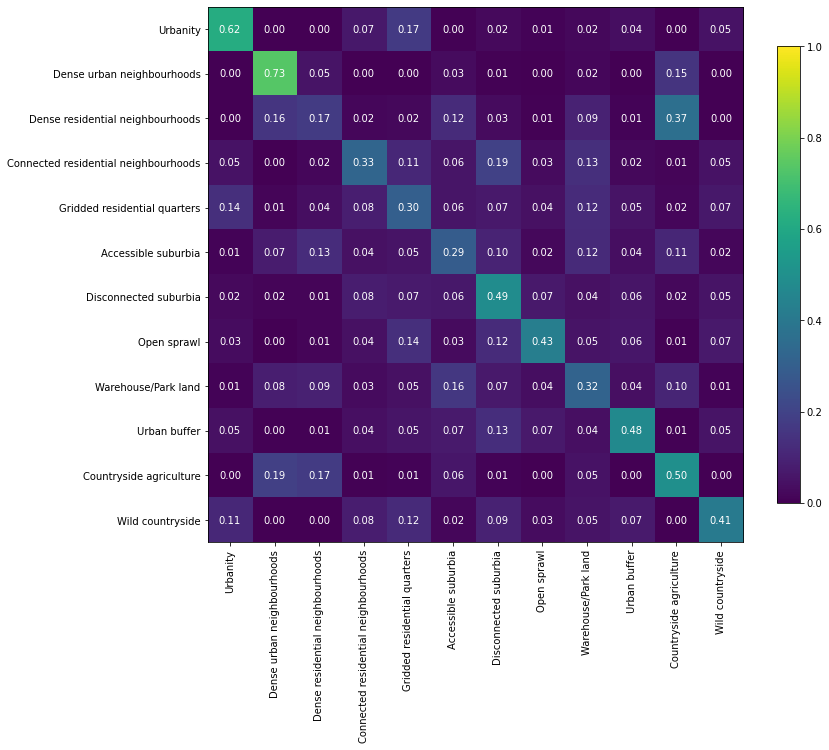
fig, ax = plt.subplots(figsize=(12, 12))
a = numpy.array(result['perf_confusion_train'])
a = a / a.sum(axis=1)[:, numpy.newaxis]
im = plt.imshow(a, cmap="viridis", vmin=0, vmax=1)
for k, j in product(range(12), range(12)):
plt.text(j, k, "{:.2f}".format(a[k, j]),
ha="center", va="center", color="w")
fig.colorbar(im, ax=ax, shrink=.7)
plt.xticks(range(12),result["meta_class_names"], rotation=90)
plt.yticks(range(12),result["meta_class_names"])
([<matplotlib.axis.YTick at 0x7fee9883fe80>,
<matplotlib.axis.YTick at 0x7fee9883f760>,
<matplotlib.axis.YTick at 0x7fee9886c850>,
<matplotlib.axis.YTick at 0x7fee986f0220>,
<matplotlib.axis.YTick at 0x7fee986f0970>,
<matplotlib.axis.YTick at 0x7fee986f6100>,
<matplotlib.axis.YTick at 0x7fee986f0940>,
<matplotlib.axis.YTick at 0x7fee986e32e0>,
<matplotlib.axis.YTick at 0x7fee986f60d0>,
<matplotlib.axis.YTick at 0x7fee986f6c40>,
<matplotlib.axis.YTick at 0x7fee986fc3d0>,
<matplotlib.axis.YTick at 0x7fee986fcb20>],
[Text(0, 0, 'Urbanity'),
Text(0, 1, 'Dense residential neighbourhoods'),
Text(0, 2, 'Connected residential neighbourhoods'),
Text(0, 3, 'Dense urban neighbourhoods'),
Text(0, 4, 'Accessible suburbia'),
Text(0, 5, 'Open sprawl'),
Text(0, 6, 'Warehouse/Park land'),
Text(0, 7, 'Gridded residential quarters'),
Text(0, 8, 'Disconnected suburbia'),
Text(0, 9, 'Countryside agriculture'),
Text(0, 10, 'Wild countryside'),
Text(0, 11, 'Urban buffer')])
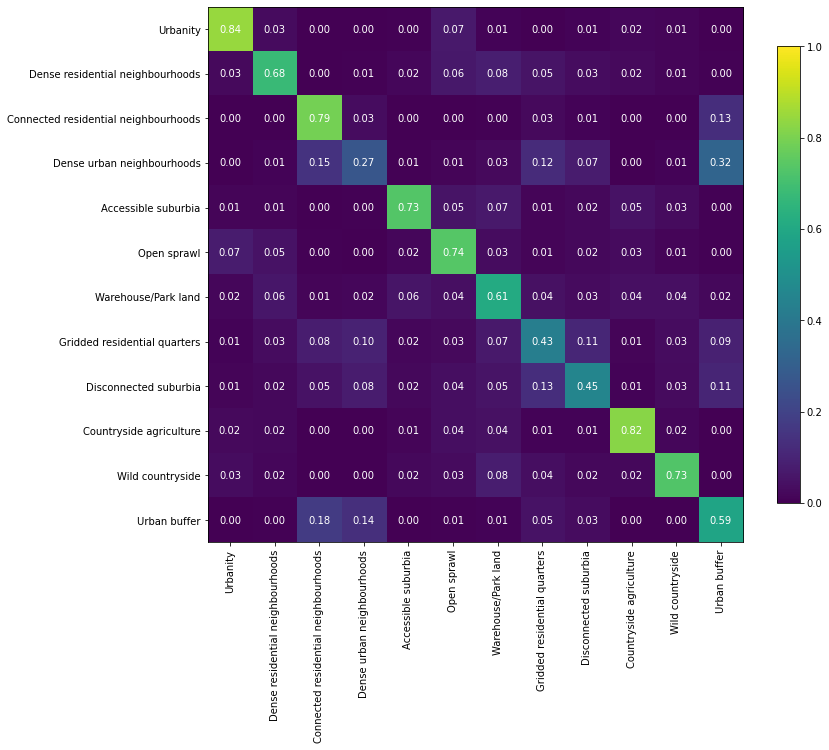
Temporal data¶
The same based on temporal chips
path = "../urbangrammar_samba/spatial_signatures/ai/gb_32_temporal/json/"
results = glob.glob(path + "*")
r = results[0]
with open(r, "r") as f:
result = json.load(f)
accuracy = pd.DataFrame(columns=["global"] + result["meta_class_names"], index=pd.Index(["train", "val", "secret"]))
accuracy.loc["train"] = [result["perf_model_accuracy_train"]] + result["perf_within_class_accuracy_train"]
accuracy.loc["val"] = [result["perf_model_accuracy_val"]] + result["perf_within_class_accuracy_val"]
accuracy.loc["secret"] = [result["perf_model_accuracy_secret"]] + result["perf_within_class_accuracy_secret"]
accuracy.loc['val'].sort_values(ascending=False).plot.bar(figsize=(22, 10), title="validation")
<AxesSubplot:title={'center':'validation'}>
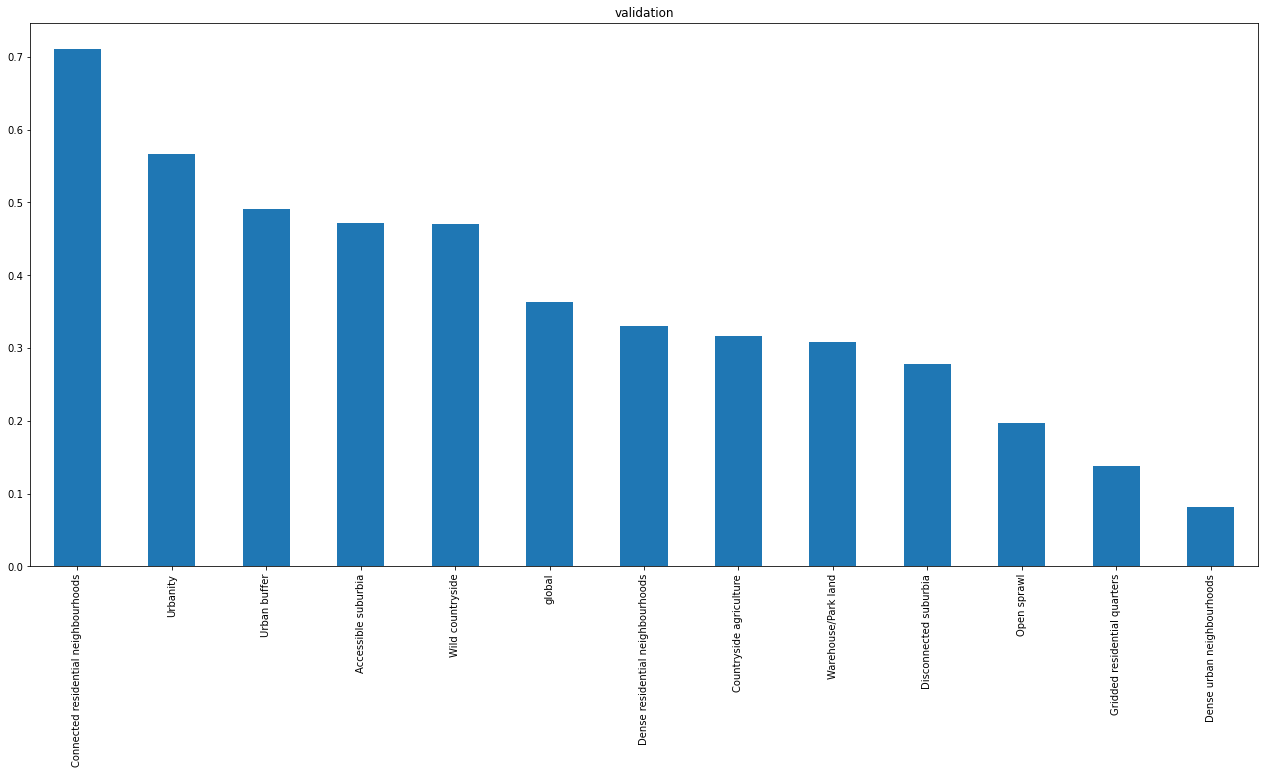
a = numpy.array(result['perf_confusion_val'])
a = a / a.sum(axis=1)[:, numpy.newaxis]
# order = numpy.array([0, 3, 1, 2, 7, 4, 8, 5, 6, 11, 9, 10], dtype=int)
# a = pd.DataFrame(a).iloc[order, order].values
fig, ax = plt.subplots(figsize=(12, 12))
im = plt.imshow(a, cmap="viridis", vmin=0, vmax=1)
for k, j in product(range(12), range(12)):
plt.text(j, k, "{:.2f}".format(a[k, j]),
ha="center", va="center", color="w")
fig.colorbar(im, ax=ax, shrink=.7)
plt.xticks(range(12),numpy.array(result["meta_class_names"])[order], rotation=90)
plt.yticks(range(12),numpy.array(result["meta_class_names"])[order])
([<matplotlib.axis.YTick at 0x7f9ac06168b0>,
<matplotlib.axis.YTick at 0x7f9ac0616130>,
<matplotlib.axis.YTick at 0x7f9ac064fa90>,
<matplotlib.axis.YTick at 0x7f9ac0421ac0>,
<matplotlib.axis.YTick at 0x7f9ac04986d0>,
<matplotlib.axis.YTick at 0x7f9ac042b340>,
<matplotlib.axis.YTick at 0x7f9ac042bac0>,
<matplotlib.axis.YTick at 0x7f9ac0434250>,
<matplotlib.axis.YTick at 0x7f9ac04349a0>,
<matplotlib.axis.YTick at 0x7f9ac0434850>,
<matplotlib.axis.YTick at 0x7f9ac042b4f0>,
<matplotlib.axis.YTick at 0x7f9ac0427790>],
[Text(0, 0, 'Urbanity'),
Text(0, 1, 'Dense urban neighbourhoods'),
Text(0, 2, 'Dense residential neighbourhoods'),
Text(0, 3, 'Connected residential neighbourhoods'),
Text(0, 4, 'Gridded residential quarters'),
Text(0, 5, 'Accessible suburbia'),
Text(0, 6, 'Disconnected suburbia'),
Text(0, 7, 'Open sprawl'),
Text(0, 8, 'Warehouse/Park land'),
Text(0, 9, 'Urban buffer'),
Text(0, 10, 'Countryside agriculture'),
Text(0, 11, 'Wild countryside')])
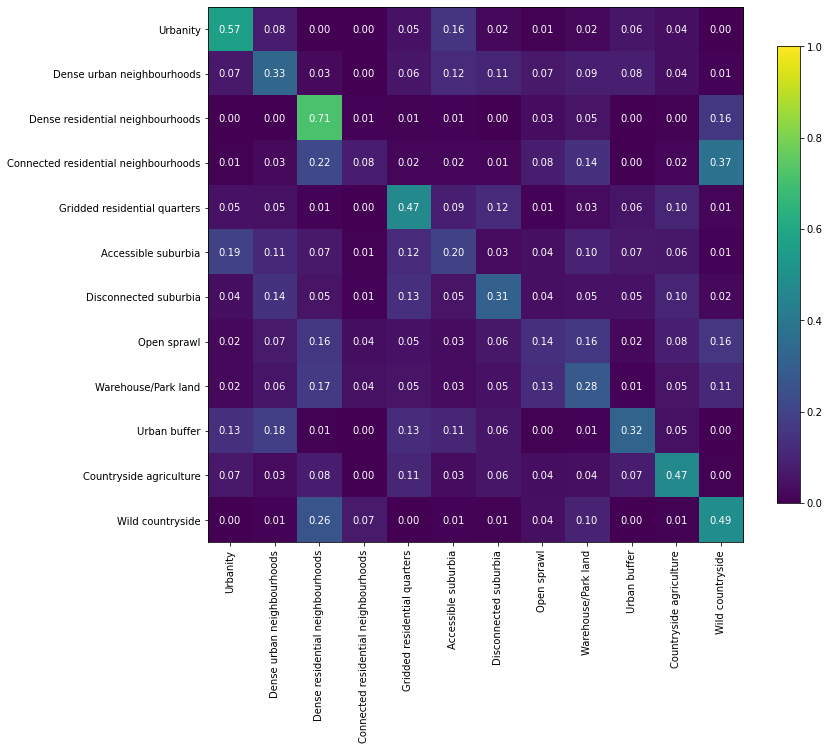
Balanced data¶
path = "../../urbangrammar_samba/spatial_signatures/ai/gb_32_balanced_named_v2/json/"
results = glob.glob(path + "*")
r = results[0]
with open(r, "r") as f:
result = json.load(f)
accuracy = pd.DataFrame(columns=["global"] + result["meta_class_names"], index=pd.Index(["train", "val", "secret"]))
accuracy.loc["train"] = [result["perf_model_accuracy_train"]] + result["perf_within_class_accuracy_train"]
accuracy.loc["val"] = [result["perf_model_accuracy_val"]] + result["perf_within_class_accuracy_val"]
accuracy.loc["secret"] = [result["perf_model_accuracy_secret"]] + result["perf_within_class_accuracy_secret"]
accuracy
| global | Urbanity | Dense residential neighbourhoods | Connected residential neighbourhoods | Dense urban neighbourhoods | Accessible suburbia | Open sprawl | Warehouse_Park land | Gridded residential quarters | Disconnected suburbia | Countryside agriculture | Wild countryside | Urban buffer | |
|---|---|---|---|---|---|---|---|---|---|---|---|---|---|
| train | 0.554045 | 0.769971 | 0.707678 | 0.615457 | 0.538372 | 0.600216 | 0.477016 | 0.589415 | 0.393829 | 0.233229 | 0.683429 | 0.462629 | 0.762229 |
| val | 0.428392 | 0.6646 | 0.507874 | 0.5828 | 0.238587 | 0.219465 | 0.254962 | 0.230869 | 0.304 | 0.2158 | 0.452206 | 0.3276 | 0.7366 |
| secret | 0.439124 | 0.6722 | 0.481884 | 0.5816 | 0.237983 | 0.211743 | 0.163166 | 0.377451 | 0.286 | 0.2152 | 0.383388 | 0.3482 | 0.7412 |
accuracy.loc['val'].sort_values(ascending=False).plot.bar(figsize=(22, 10), title="validation")
<AxesSubplot:title={'center':'validation'}>
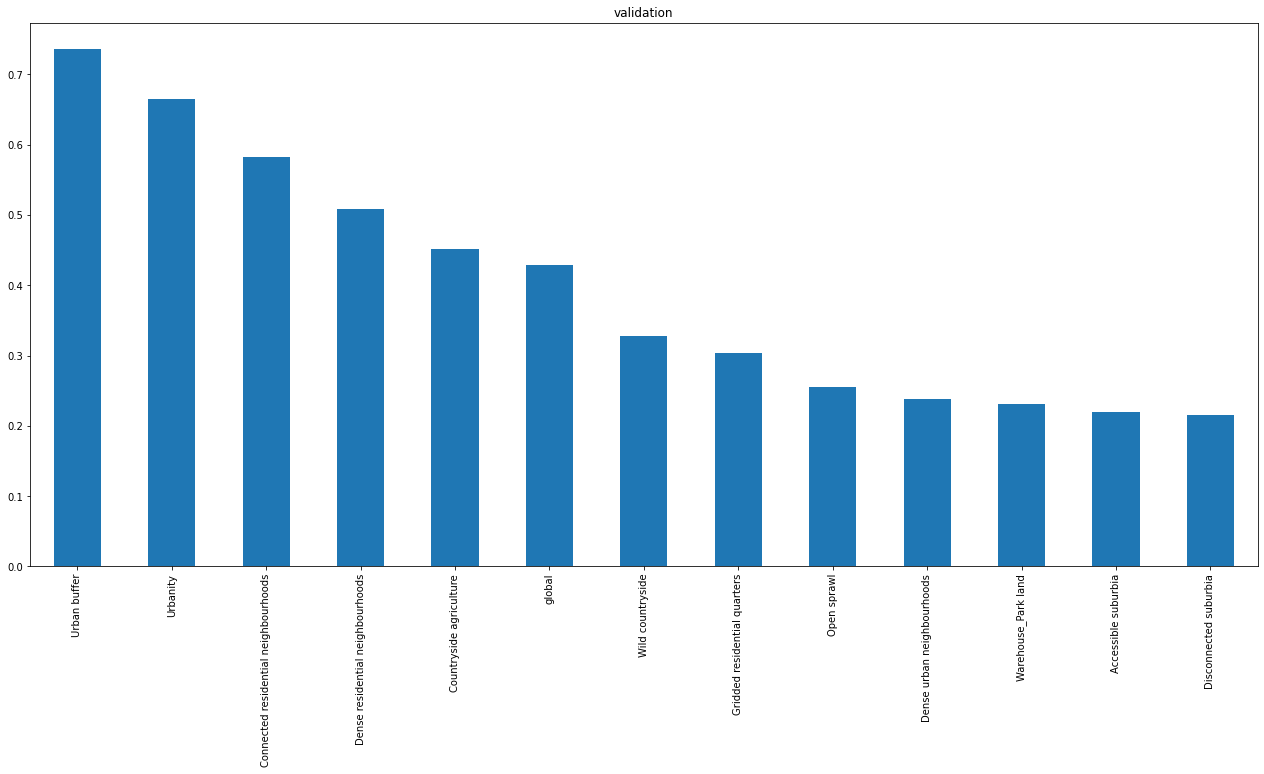
a = numpy.array(result['perf_confusion_val'])
a = a / a.sum(axis=1)[:, numpy.newaxis]
order = numpy.array([9, 4, 3, 1, 6, 0, 5, 7, 10, 8, 2, 11], dtype=int)
a = pd.DataFrame(a).iloc[order, order].values
fig, ax = plt.subplots(figsize=(12, 12))
im = plt.imshow(a, vmin=0, vmax=1, cmap='viridis')
for k, j in product(range(12), range(12)):
plt.text(j, k, "{:.2f}".format(a[k, j]),
ha="center", va="center", color="w")
fig.colorbar(im, ax=ax, shrink=.7)
ticks = numpy.array(sorted(result["meta_class_names"]))[order]
plt.xticks(range(12),ticks, rotation=90)
plt.yticks(range(12),ticks)
plt.savefig("figs/image_class_conf.pdf")
